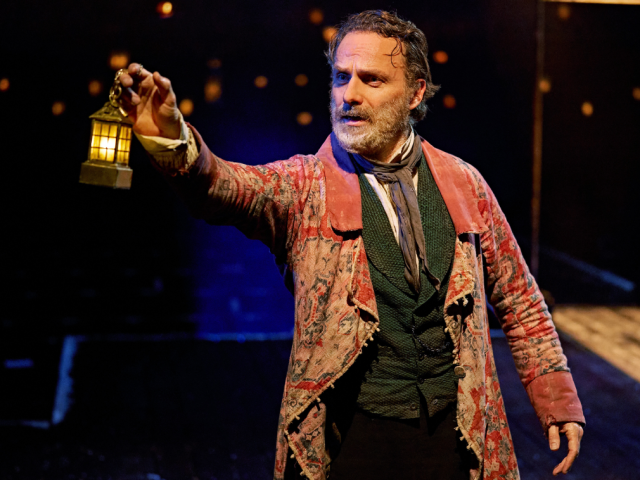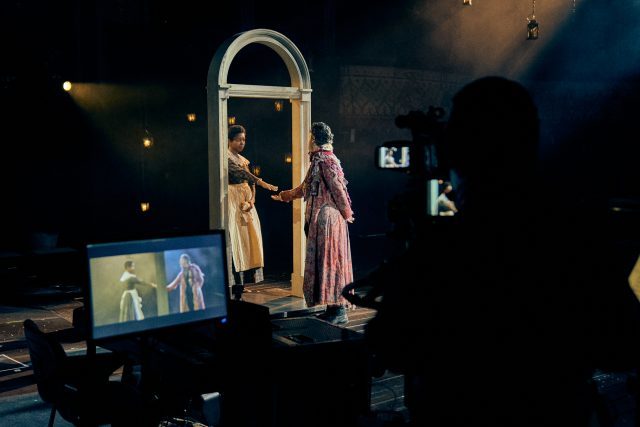
Andrew Lincoln shines a light on a different aspect of Scrooge’s psyche in Old Vic adaptation (photo by Manuel Harlan)
A CHRISTMAS CAROL
The Old Vic, London
Through December 24, £10-£65
www.oldvictheatre.com
For its fourth “In Camera” presentation, the Old Vic has revived Jack Thorne’s 2017 reimagining of Charles Dickens’s A Christmas Carol, which moved to Broadway in fall 2019 and plans to return next holiday season. Thorne’s bold adaptation minimizes the traditional ghost story elements and instead develops a narrative that focuses on Ebenezer Scrooge’s childhood trauma (George Samuel Townsend plays him as a boy, Andrew Lincoln as an adult) and how it influenced his development into the greedy, heartless man he now is — revealing the psychological damage wrought by a demanding, overbearing father (Michael Rouse), never mentioned in Dickens’s original; the boy’s relationship with his adored sister, Fan (Melissa Allan), named only once by Dickens; and his one chance at love with Belle (Gloria Obianyo), the daughter of his employer, Mr. Fezziwig (Clive Rowe), who in this version runs a funeral parlor, although Dickens himself never elucidates Fezziwig’s business.
The heart-tugging Cratchit family — Scrooge’s clerk, Bob (John Dagleish), Bob’s wife (Maria Omakinwa), and their children, including the lame Tiny Tim (Rayhaan Kufuor-Gray, Lara Mehmet, Lenny Rush, or Eleanor Stollery) — is almost an afterthought in Thorne’s retelling, while Scrooge’s deceased partner, Jacob Marley (Rouse), is given more prominence, as is Scrooge’s nephew, Fred (Eugene McCoy). The Ghosts of Christmas Past, Present, and Future are portrayed by a trio of women (Julie Jupp, Golda Rosheuvel, and a surprise third character) who are not daunting spirits but rather have much more intimate connections with Scrooge.

Old Vic’s “In Camera” livestreamed production of A Christmas Carol follows Covid-19 protocols (photo by Manuel Harlan)
The Old Vic’s “In Camera” series, live plays streamed direct from its London stage, adhering to all Covid-19 protocols and performed without an audience, previously offered very short runs of Brian Friel’s Faith Healer with Michael Sheen, David Threlfall, and Indira Varma, Stephen Beresford’s Three Kings with Andrew Scott, and Duncan MacMillan’s Lungs with Claire Foy and Matt Smith. Helmed by Tony-winning artistic director Matthew Warchus (Matilda, God of Carnage), A Christmas Carol is riveting theater for most of its two-hour length. The action is filmed with multiple cameras that give tantalizing close-ups as well as long views, while the tech crew often utilizes split screens so expertly that it’s sometimes difficult to figure out whether actors are actually next to each other or are socially distancing, especially during several handshakes.
Lincoln (The Walking Dead, Parlour Song) is sensational in one of the most familiar roles ever written, playing Scrooge as a flawed human being rather than a brutally cold and unforgiving ogre. It’s a welcome change, as are the changes brought to other minor characters, with stand-out performances by Obianyo, Rowe, and Rosheuvel. The cast also features Rosanna Bates as Jess, Tim van Eyken as Nicholas, and Sam Lathwood as Ferdy. This is not your grandparents’ Christmas Carol.
The set by Rob Howell, who also designed the period costumes, is anchored by a slotted-wood floor, with frames without doors through which characters enter and exit and dozens of lanterns hanging from the ceiling. At the 2017-19 in-person shows, audience members received clementines and cookies; the Old Vic tries to maintain a level of interactivity by having an online quiz that begins about an hour before the play starts and by providing a family activity pack that can be downloaded for free here.
Which brings us to the ending. Throughout the show, Christmas carols are played by a masked band in the balcony, consisting of pianist and musical director Will Stuart, cellists Christopher Allan and Pedro Vieira da Silva, violinist Clare Taylor, and clarinetist Martin Robertson. The songs often get in the way of the narrative, especially with Thorne’s (Harry Potter and the Cursed Child, His Dark Materials) unexpected twists, but it all becomes particularly annoying when the music, acting, and staging all combine to go way over the top during Scrooge’s rethinking of what Christmas means. What was a gripping, tense tale instantaneously lapses into a tired traditional holiday finale, turning its back on everything that came before. It had challenged what we know about this classic story but then settled for the lowest common denominator for its conclusion, which is a shame. Or, of course, I’m just being a scrooge. Bah, humbug.